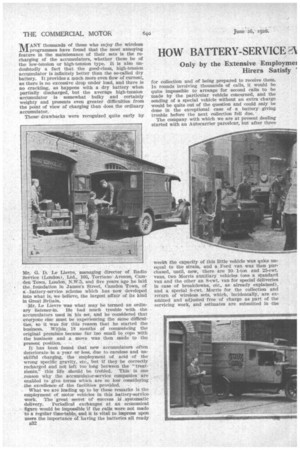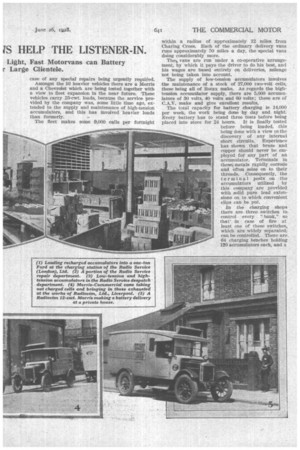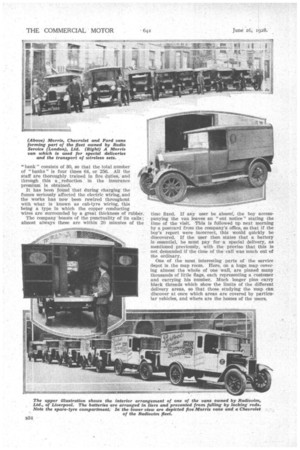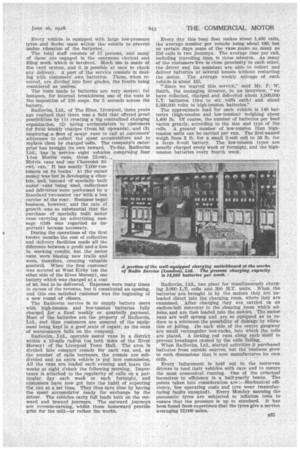HOW BATTERY-SERVICE ?A IS HELP THE LISTENER-IN.
Page 58

Page 59

Page 60

Page 61

If you've noticed an error in this article please click here to report it so we can fix it.
Only by the Extensive Employmel Hirers Satisfy ' Light, Fast Motorvans can Battery r Large Clientele.
MANY thousands of those who enjoy the wireless programmes have found that the most annoying feature in the maintenance of their sets is the recharging of the accumulators, whether these be of the low-tension or high-tension type. It is also undoubtedly a fact that the good-class, high-tension accumulator is infinitely better than the so-called dry battery. It provides a much more even flow of current, as there is no excessive drop under load, and there is no crackling, as happens with a dry battery when partially discharged, but the average high-tension accumulator is somewhat bulky and certainly weighty and presents even greater difficulties from the point of view of charging than does the ordinary accumulator.
These drawbacks were recognized quite early by Mr. G. D. Le Lievre, managing director of Radio Service (London), Ltd., 105, Torriano Avenue, Camden Town, London, N.W.5, and five years ago he laid the foundation in James's Street, Camden Town, of abattery-service scheme which has now developed into what is, we believe, the largest affair of its kind hi Great Britain.
Mr. Le Lievre was what may be termed an ordin • ary listener-in. He had much trouble with the accumulators used in his set, and he considered that eVeryone else must be 'experiencing the same difficulties, so it was for this reason that he started the business. Within 18 months of commencing the original premises became far too small to cope with the business and a move was then made to the present position. • It has been found that new accumulators often deteriorate in a year or less, due to careless and unskilfhl charging, the employment of acid of the wrong specific gravity, etc., but if they be correctly recharged and not left too long between the "treatmeats," this life should be trebled. This is one reason why the accumulator-service companies are enabled to give terms which are 'so low considering
the excellence' of the facilities provided. .
• What we are leading up to by these remarks is the employment of motor vehicles in this •battery-service work. The great secret of success is systematic delivery. Periodical exchanges at an economical figure would be impossible if the calls were not made to a regular time-table, and it is vital to impress upon users the importance ok having the batteries all ready B32 for collection and of being prepared to receive them. In rounds involving thousands of calls, it would be quite impossible to arrange for second calls to be made by the particular vehicle concerned, and the sending of a special vehicle without an extra charge would be quite out of the question and could only be done in the exceptional case of a battery giving trouble before the next collection fell due. • The company with which we are at present dealing started with an Autocarrier parcelcar, but after three week% the capacity of this little vehicle was quite unequal to the strain, and a Ford van was then purchased, until, now, there are 10 1-ton and 25-cwt. vans, two Morris auxiliary vehicles (one a standard van and the other an 8-cwt. van for special deliveries in case of breakdowns, etc., as already explained), and a special 8-cwt. Morris for the collection and return of wireless sets, which, incidentally, are examined and adjusted free of charge as part of the servicing work, and estimates are submitted in the case of any special repairs being urgently required.
Amongst the 10 heavier vehicles there are a Morris and a Chevrolet which are being tested together with a view to fleet expansion in the near future. These vehicles carry 25-cwt. loads, because the service provided by the company was, some little time ago, extended to the supply and maintenance of high-tension accumulators, and this has involved heavier loads than formerly.
The fleet makes some 9,000 calls per fortnight
within a radius of approximately 12 miles from Charing Cross. Each of the ordinary delivery vans runs approximately 50 miles a day, the special vans doing considerably more.
They vans are run under a co-operative arrangement, by which it pays the driver to do his best, and his wages are based entirely on deliveries, mileage not being taken into account.
The supply of low-tension accumulators involves the maintenance of a stock of 27,000 two-volt cells, these being all of Rotax make. As regards the hightension accumulator supply, there are 5,000 accumulators of 30 volts, 90 volts and 60 volts; these are of C.A.V. make and give excellent results,
The total capacity for battery charging is 14,000 per week, the work being done by day and night. Every battery has to stand three tests before being placed into store for 24 hours. It is finally tested before being loaded, this being done with a view to the discovery of any internal short circuits. Experience has shown that brass and copper should never be employed for any part of an accumulator. Terminals in these;.metals rapidly corrode and often seize on to their threads. Consequently, the terminal posts on the accumulators utilized by this company are provided with solid pure lead extensions on to which convenient clips can be put.
In the charging shops there are three switches to control every "bank," so that in case of fire at least one of these switches, which are widely separated; can be controlled. There are 64 charging benches holding 120 accumulators each, and a
"bank" consists of 30, so that the total number of "banks" is four times 64, or 256. All the staff are thoroughly trained in fire duties, and through this a ,reduction in the insurance premium is obtained.
It has been found that during charging the fumes seriously affected the electric wiring, and the works has now been rewired throughout with what is known as cab-tyre wiring, this being a type in which the copper conducting wires are surrounded by a great thickness of rubber.
The company 'bOasts of the punctuality of its calls; almost always these are within 20 minutes of the
time fixed. If any user be absent, the boy accompanying the van leaves an "out notice" stating the time of the visit. This is followed up next morning by a postcard from the company's office, so that if the boy's report were incorrect, this would quickly be discovered. If the user then states that a battery Is essential, he must pay for a special delivery, as mentioned previously, with the proviso that this is not, demanded if the time of the call was much out of the ordinary.
One of the most interesting parts of the service depot is the map room. Here, on a huge map covering almost the whole of one wall, are pinned many thousands of little flags, each representing a customer _ and carrying his number. Much longer pins carry black threads which show the limits of the different delivery areas, so that those studying the map can discover at once which areas are covered by particular vehicles, and where are the homes of the users.
Every vehicle is equipped with large low-pressure tyres and Sorbo mats within-thevehicle toprevent undue vibration of the batteries... "
The total staff consists of 57 persons, and many of these are engaged in the enormous clerical and filing work. which is involved. Much use is made Of the card system, and it is possible at once to check any delivery. A part of the service consists in dealing with customers' own batteries. These, when received, are divided into tour grades, the fourth being considered as useless.
The 'tests made to batteries are very severe.; for instance, for internal breakdowns one of the tests is the imposition of 150 amps. for 5 seconds across the battery.
Radiovim, Ltd., of The Elms, Liverpool, three years ago realized that there was a field that offered great possibilities by (1) creating a big centralized charging organization, (2) hiring accumulators to customers for* flied Weekly charges MOM 8d. upwards), and (3) 'employing a fleet of motor vans to call at .customers' addresses to collect the spent accuandators and to replace them by' Charged-cells. The Company's enterPrize has brotight its own reward. . To-day, Radiovim Ltd., has in service eight vehicles comprising four .1-ton Morris vans,' three 12-cwt;_ Morris .vans and one Chevrolet 10cwt. van. Ft has nearly 7,000 custoniers on its books. At the outset money Was lost in developing a ellen= tele, and,, instead of specially built motor vans. being Used, collections and deliVeries were performed by a Standard two-seater car•with a box carrier at the rear. Business begat. business, however, and the rate of growth was so substantial that the purchase of specially built motor vans carrying an advertising message (this was regarded as important) became necessary.
During the operations of the first twelve months the cost of collection and delivery facilities made all the diference between a profit and a loss in working results, but the motor vans were blazing new trails and were, therefore, creating valuable goodwill. When the first customer was secured at West Kirby (on the other side of the River Mersey), one battery which was charged at a cost of 8d. had to be delivered. Expenses were many times in excess of the revenue, but it constituted an opening, and this one satisfied customer was the beginning of a new round of clients.
The Radiovim 'service is to supply battery users with high-tension and low-tension batteries fully charged for a fixed weekly or quarterly payment. Most of the batteries are the property of Radiovim, Ltd., and thus customers are assured of the equipment being kept in a good state of repair, as the onus of maintenance falls on the company.
Radiovim, Ltd., operates motor vans in a district within a 10-mile radius (on both sides of the River Mersey) of the Liverpool Town Hall. The area is divided into compact rounds for each van and, as the number of calls increases, the rounds are subdivided and an extra vehicle is put into commission. All the vans are loaded each evening and leave the works at eight o'clock the following morning. Importance is attached to the regularity of calls on a particular day each week or each fortnight, and customers have now got into the habit of expecting the van at a set time. They thus save time by having the spent accumulator ready for exchange by the driver. The vehicles carry full loads both on the outward and inward journeys. The outward journeys are revenue-earning, whilst those homeward provide grist for the mill—or rather the works.
Every day this busy fleet makes about 1,400 calls, the average number per vehicle being about 180, but on certain days some of the vans make as many as 250 calls in two journeys. The average time per call, including travelling time, is three minutes. As many of the customers live in close proximity to each other, the driver and his assistant are able to collect and deliver batteries at several houses without restarting the motor. The average weekly mileage of each -vehicle is about 135.
-" Since we started this service," said Mr. P. W. Smith, the managing director, in an interview, "we have collected, charged and delivered about 1,500,000 L.T. batteries (two. to six volts each) and about 3,500,000 volts in high-tension batteries."
The approximate load for each vehicle is 140 batteries (high-tension and low-tension) Weighing about 1,400 lb. Of course, the number of batteries per load varies greatly, according to the size and type of the cells. A greater number of low-tension than hightension units can be carried per van. The first-named weigh from 3 lb. for a small 2-volt cell to 56 lb. for a large 6-volt battery. The low-tension types are usually charged every week or fortnight, and the hightension batteries every fourth week.
Radiovim, Ltd., has plant for simultaneously charging .3,000 L.T. cells and 300 H.T. units, When the batteries are brought in by the motors they are unloaded direct into the charging room, where they are examined. After charging they are carried on an endless-belt conveyer to the 'cleaning room which adjoins, and are then loaded into the motors. The motor :vans are well sprung and are so equipped as to reduce to a minimum the possibility of damage by vibration or jolting. ,On each side .of the centre gangway are small rectangular box-racks, into which the cells are placed. A locking rod runs along each Shelf to prevent breakages caused by the cells falling.
When Radiovim, Ltd., started activities it purchased batteries from outside sources, but the business grew to such dimensions that it now manufactures its own cells.
Every inducementheld out to the motorvan drivers to tend their ehicles with care and to ensure the most economical running. One of the principal Incentives to efficiency is a half-yearly bonus. The points taken into consideration are :—Mechanical efficiency, low operating costs and tyre wear (manufacturing faults excepted). Every Monday morning the pneumatic tyres are subjected to inflation tests to ensure that the pressure is up to standard. It has been found from experience that the tyres give a service averaging npoo miles.




















































































































